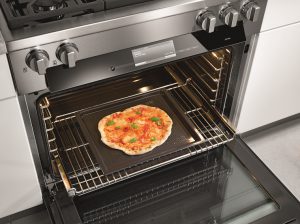First Check Your Calibration
The first step to determining if your oven is not cooking evenly is to check your calibration. Even if the center of your food is practically uncooked, while the edges are burned, it could be that your oven is poorly calibrated.
Over time, the internal temperature of your oven can lose accuracy and so it isn’t matching what you have set on the temperature dial. If you have set the dial to 350 degrees, but the oven is actually closer to 400, it would result in well-done edges and only warm insides.
Fortunately, re-calibrating an oven is usually a relatively simple fix, and you should find instructions in your owner’s manual.
Perform a Hot Spots Test
If you have determined that your oven has been properly calibrated, you need to check how it is actually cooking. There are several methods that can be used to perform a hot spots test without requiring to buy specialist equipment. One way is to bake a cake, and if you can see that some parts are done, and you have raw batter after following the instructions precisely, it indicates a problem. Unfortunately, this only confirms a problem but no further information. Another idea is to lay bread across a cookie sheet and put it in the oven. You should be able to see where the bread browns and where it is still white. This will help you to pinpoint where the hot and cold spots in the oven are.
Once you’ve determined that there is uneven cooking, you’ll need to identify the underlying issue.
A Faulty Broil or Bake Element
If either the broil or bake element has burned out, you can expect uneven heating. When the broil element isn’t working, only the bake element is heating the oven and vice versa. This leads to uneven heating during preheating.
It may be possible to visually assess if either element has burned out. Preheat your oven and look to see whether both the broil element at the top and the bake element at the bottom are both glowing red. If one isn’t red, it is faulty or burned out and will need to be replaced.
Temperature Sensor Fault
Over time, the temperature sensor inside your oven can wear out. Firstly check to see if your sensor has shifted and is not touching the oven wall. If so, you will need to re-position to it is no longer in contact with the wall. You can also use an ohmmeter to test if the sensor is operating correctly. As the temperature in the oven cavity rises, the temperature sensor resistance reading should also increase.
If your temperature sensor has developed a fault, it will need to be replaced. You can tackle this yourself or call in a professional.
Adjust Your Technique
Some ovens just cook differently. You will notice on cooking shows that they advise a rough cooking temperature for recipes for this reason. In this case, you may just need to adjust your technique. You may need to use different cookware such as glassware to even out the cooking or adjust your racks. It may simply be that your baking pans have browned with age and are no longer reflecting heat. So, consider replacing them or give them a deep clean using vinegar and baking soda with hot water to restore the shine.
If you’re still having issues with your oven, you can rely on a home appliance repair technician to provide long-term solutions. Be sure to consult an experienced professional for advice and a resolution to your oven problems.
